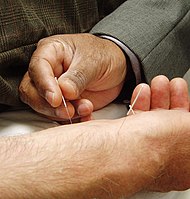
Photo from wikipedia
OBJECTIVE Diabetic foot wounds account for up to one third of diabetes-related healthcare expenditure, and are the greatest cause of extremity amputation in Canada. Physicians encounter patients with such wounds… Click to show full abstract
OBJECTIVE Diabetic foot wounds account for up to one third of diabetes-related healthcare expenditure, and are the greatest cause of extremity amputation in Canada. Physicians encounter patients with such wounds in all specialties, particularly as generalists in medical wards and emergency departments. However, there is a dearth of literature on the optimal way to teach and assess the management of these patients. Given the importance of assessment for learning in the shift towards competency -based medical education, we aimed to develop an assessment tool and build validity evidence for its use in this context. METHODS A consensus process involving 9 Canadian experts in diabetic wound management was used to develop the Diabetic Wound Assessment Learning Tool [DiWALT] items and two 10-minute simulation-based testing scenarios. The simulators used were modified from commercially available models to serve the testing scenarios. Validity evidence for the DiWALT was subsequently evaluated by assessing 24 physician participants' performance during the two scenarios. All participants were novices [<50 cases managed]. Two assessors independently rated participants using the DiWALT. Evidence for was organized using Kane's Validity framework and included Cronbach's Alpha for inter-item consistency, as well as test-retest and inter-rater reliability using the intra-class correlation coefficient [ICC]. RESULTS Cronbach's alpha was 0.92 implying high internal consistency. Test-retest reliability was also excellent (ICC=0.89 [CI 0.76, 0.95] for single measures and ICC=0.94 [CI 0.86, 0.98] for average measures). Inter-rater reliability was fair for single measures with ICC=0.68 [CI 0.65, 0.71] and good for average measures ICC=0.81 [CI 0.79, 0.83]. CONCLUSIONS These results demonstrate that the DiWALT consistently and reliably evaluates competence in diabetic wound management during simulated cases utilizing a small, homogeneous sample of physicians. Further work is necessary to quantify sources of error in the assessment scores, to establish validity evidence when used to assess larger, more heterogeneous participants, and to identify how well the DiWALT differentiates between different experience levels.
Journal Title: Journal of vascular surgery
Year Published: 2020
Link to full text (if available)
Share on Social Media: Sign Up to like & get
recommendations!